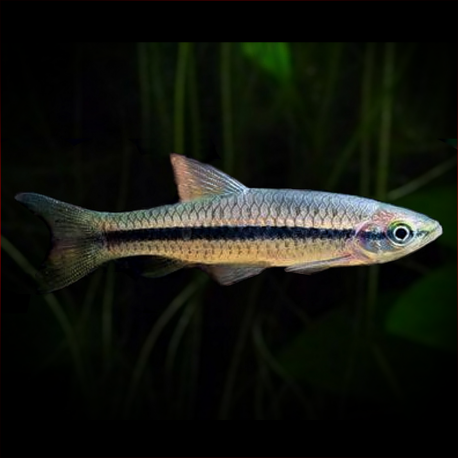More info
Datasheet
| Minimum Tank Size | 113 litres / 29.85 US gallons |
| Maximum Size | 9.1cm / 3.58inches |
| Temperature | 22°C / 71.60°F - 26°C / 78.80°F |
| Hardness | 2-10ºdH |
| pH | 5.0-7.5 |
Behaviour
The Brilliant Rasbora is known for its peaceful nature, making it an excellent addition to a community tank with various fish species. This fish thrives in a group of at least six individuals, displaying better colors and a more natural behavior when kept with conspecifics. It can coexist with other small cyprinids, tetras, livebearers, dwarf cichlids, catfish, and loaches. In a biotope setup, it can be housed with other Malaysian/Bornean blackwater species like Puntius lineatus, P. pentazona, Trigonopoma gracile, T. pauciperforatum, Brevibora dorsiocellata, and Pangio (kuhli) loaches.
Feeding and Diet
As a micropredator in the wild, the Brilliant Rasbora feeds on small insects, worms, crustaceans, and zooplankton. When kept in an aquarium, it accepts dried foods but should have a varied diet that includes live and frozen foods such as Daphnia and Artemia. Regular feeding of small live and frozen fare not only enhances its coloration but also stimulates breeding behavior.
Reproduction & Dimorphism
Breeding the Brilliant Rasbora is achievable with proper conditions. Like other cyprinids, it is an egg-scattering, continuous spawner that shows no parental care. To promote breeding, a densely planted and mature aquarium is essential. Controlled breeding can be initiated in a separate container with subdued lighting, where the eggs can fall through a mesh to protect them from adults. Sexually mature females are larger and rounder-bellied compared to males.
Habitat and Distribution
This species originates from southern Thailand, Peninsular Malaysia, Singapore, and the Greater Sunda islands of Borneo and Sumatra. Inhabiting blackwater streams in ancient forest peat swamps, the Brilliant Rasbora prefers soft and acidic water characterized by tannins from decaying organic matter. Its habitat is threatened by human activities like plantation farming and construction. While mainly found in blackwater environments, it can adapt to clear waters in certain areas.

